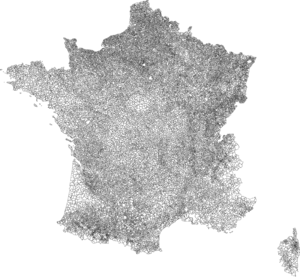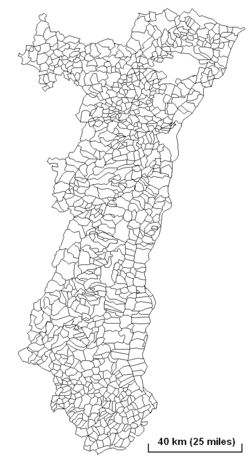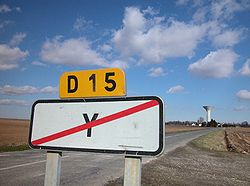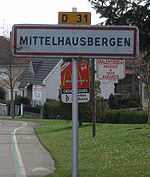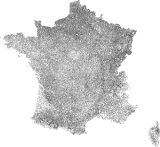
Communes of France
Encyclopedia
The commune is the lowest level of administrative division in the French Republic
. French communes are roughly equivalent to incorporated municipalities
or villages in the United States
or Gemeinden in Germany
. French communes have no exact equivalent in the United Kingdom
, but are closest to parish
es, towns or cities.
A French commune can be a city of two million inhabitants as in Paris
; a town of ten thousand people—or just a ten-person hamlet
.
communia
, meaning a small gathering of people sharing a common life; from Latin
communis, things held in common.
, 36,569 of them in metropolitan France
and 212 of them overseas. This is a considerably higher total than that of any other European country. This peculiarity is explained in detail in the history section below; briefly, French communes still largely reflect the division of France into villages or parish
es at the time of the French Revolution
more than two centuries ago.
France
The French Republic , The French Republic , The French Republic , (commonly known as France , is a unitary semi-presidential republic in Western Europe with several overseas territories and islands located on other continents and in the Indian, Pacific, and Atlantic oceans. Metropolitan France...
. French communes are roughly equivalent to incorporated municipalities
Municipality
A municipality is essentially an urban administrative division having corporate status and usually powers of self-government. It can also be used to mean the governing body of a municipality. A municipality is a general-purpose administrative subdivision, as opposed to a special-purpose district...
or villages in the United States
United States
The United States of America is a federal constitutional republic comprising fifty states and a federal district...
or Gemeinden in Germany
Germany
Germany , officially the Federal Republic of Germany , is a federal parliamentary republic in Europe. The country consists of 16 states while the capital and largest city is Berlin. Germany covers an area of 357,021 km2 and has a largely temperate seasonal climate...
. French communes have no exact equivalent in the United Kingdom
United Kingdom
The United Kingdom of Great Britain and Northern IrelandIn the United Kingdom and Dependencies, other languages have been officially recognised as legitimate autochthonous languages under the European Charter for Regional or Minority Languages...
, but are closest to parish
Parish
A parish is a territorial unit historically under the pastoral care and clerical jurisdiction of one parish priest, who might be assisted in his pastoral duties by a curate or curates - also priests but not the parish priest - from a more or less central parish church with its associated organization...
es, towns or cities.
A French commune can be a city of two million inhabitants as in Paris
Paris
Paris is the capital and largest city in France, situated on the river Seine, in northern France, at the heart of the Île-de-France region...
; a town of ten thousand people—or just a ten-person hamlet
Hamlet (place)
A hamlet is usually a rural settlement which is too small to be considered a village, though sometimes the word is used for a different sort of community. Historically, when a hamlet became large enough to justify building a church, it was then classified as a village...
.
General characteristics
The French word commune appeared in the 12th century, from Medieval LatinMedieval Latin
Medieval Latin was the form of Latin used in the Middle Ages, primarily as a medium of scholarly exchange and as the liturgical language of the medieval Roman Catholic Church, but also as a language of science, literature, law, and administration. Despite the clerical origin of many of its authors,...
communia
Medieval commune
Medieval communes in the European Middle Ages had sworn allegiances of mutual defense among the citizens of a town or city. They took many forms, and varied widely in organization and makeup. Communes are first recorded in the late 11th and early 12th centuries, thereafter becoming a widespread...
, meaning a small gathering of people sharing a common life; from Latin
Latin
Latin is an Italic language originally spoken in Latium and Ancient Rome. It, along with most European languages, is a descendant of the ancient Proto-Indo-European language. Although it is considered a dead language, a number of scholars and members of the Christian clergy speak it fluently, and...
communis, things held in common.
Total number of communes
As of January 9, 2008, there were 36,781 communes in FranceFrance
The French Republic , The French Republic , The French Republic , (commonly known as France , is a unitary semi-presidential republic in Western Europe with several overseas territories and islands located on other continents and in the Indian, Pacific, and Atlantic oceans. Metropolitan France...
, 36,569 of them in metropolitan France
Metropolitan France
Metropolitan France is the part of France located in Europe. It can also be described as mainland France or as the French mainland and the island of Corsica...
and 212 of them overseas. This is a considerably higher total than that of any other European country. This peculiarity is explained in detail in the history section below; briefly, French communes still largely reflect the division of France into villages or parish
Parish
A parish is a territorial unit historically under the pastoral care and clerical jurisdiction of one parish priest, who might be assisted in his pastoral duties by a curate or curates - also priests but not the parish priest - from a more or less central parish church with its associated organization...
es at the time of the French Revolution
French Revolution
The French Revolution , sometimes distinguished as the 'Great French Revolution' , was a period of radical social and political upheaval in France and Europe. The absolute monarchy that had ruled France for centuries collapsed in three years...
more than two centuries ago.
| |||||||


